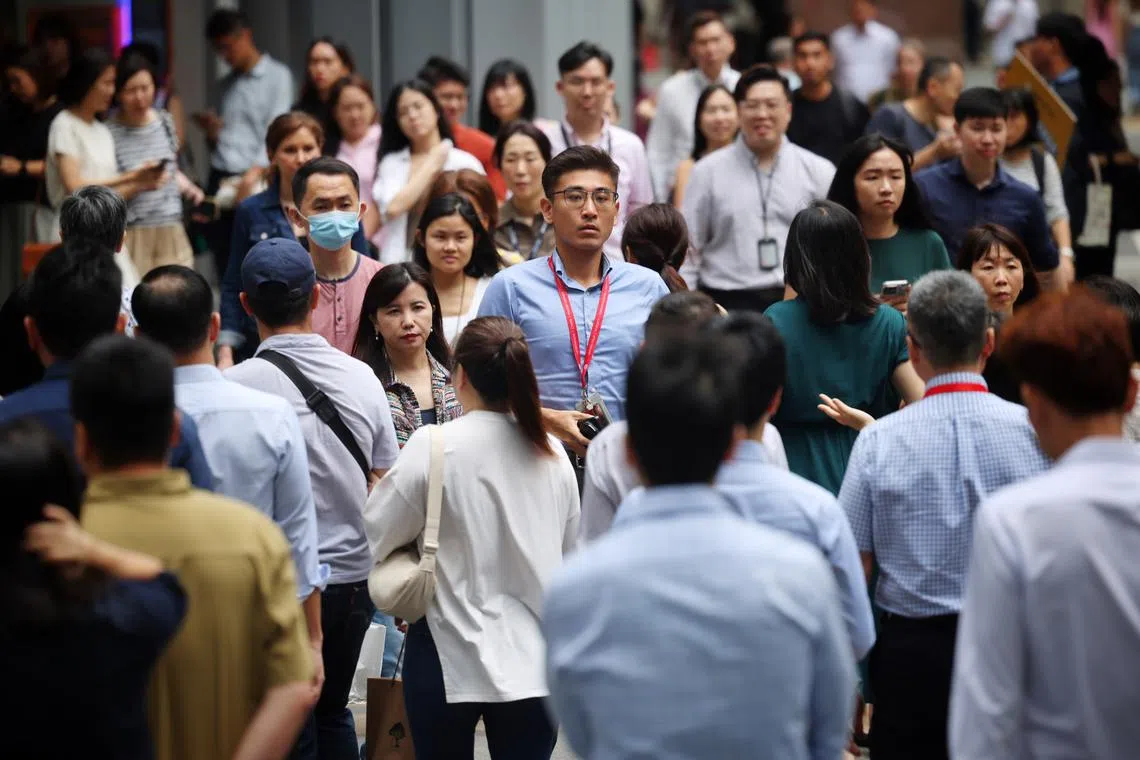Fewer S’pore retrenchments in 2024 than in 2023; resident employment grew: MOM
Sign up now: Get tips on how to grow your career and money

There were 3,600 retrenchments in the fourth quarter of 2024, up from 3,050 in the previous quarter.
ST PHOTO: JASON QUAH
Follow topic:
SINGAPORE - Layoffs rose in the last quarter of 2024, but the year still closed with fewer layoffs than in 2023, and more Singapore residents in jobs.
There were 3,600 retrenchments in the fourth quarter of 2024, up from 3,050 in the previous quarter, according to preliminary labour market data released by the Ministry of Manpower (MOM) on Jan 27.
The ministry said the latest figure is still in line with norms for non-recession years.
Overall, the number of retrenchments fell to 12,930 in 2024, from 14,590 in 2023, with no significant increases across sectors. Corporate restructuring was the main reason companies cited for laying off workers.
CGS International economic adviser Song Seng Wun noted there were retrenchments in the technology, e-commerce, and food and beverage (F&B) sectors.
He added that for F&B, the rate at which new businesses open has slowed down, while the rate of closures has increased. This could be due in part to people travelling more, thanks to the strong Singapore dollar in 2024, meaning they tend to eat and drink out less locally.
For the full year, the number of residents – Singaporeans and permanent residents – in employment grew, unlike in 2023 when there was a decline in resident employment. On the other hand, the growth in the number of foreigners employed here is expected to slow “considerably” from 2023, said the ministry.
As a result, total employment growth in 2024 is expected to slow to 45,500, lower than the 78,800 increase seen in 2023, excluding foreign domestic workers. MOM will release further details on the breakdown of employment growth in a regular report due in mid-March.
In the fourth quarter, while Singapore’s total employment continued to grow, resident employment growth slowed to 8,700, down from 22,300 in the preceding quarter but higher than the growth of 3,900 in the fourth quarter of 2023.
Economists told The Straits Times that Singapore’s total employment saw a moderate increase in 2024 as the local economy was normalising further to pre-pandemic levels.
Said Mr Song: “Businesses that had fired and hired were mostly done.”
There were more Singapore residents with jobs in higher-skilled sectors such as professional services, financial services, and health and social services, while retail trade also experienced an uptick in employment in the fourth quarter due to the year-end seasonal hiring.
MOM also said that the increase in foreign employment remains concentrated in the construction sector, as seen in the past quarters. This was driven primarily by hiring for lower-skilled jobs held by work pass holders. But it noted that foreign employment in information and communications and insurance services has declined.
Meanwhile, the seasonally adjusted unemployment rate of Singaporeans increased slightly from 2.7 per cent in September 2024 to 2.9 per cent in October 2024. But it then remained at that level in November and December and was within the typical range for non-recession periods, said the ministry.
The overall unemployment rate was unchanged at 1.9 per cent from September to December, while the rate for residents was 2.6 per cent in September and 2.8 per cent from October to December.
For the full year, the annual average rates were similar to 2023.
Looking ahead, employment growth is expected to be slower in 2025 due to global uncertainties and market volatility, noted the ministry. But it said that in the near term, there are signs of optimism.
Its forward-looking polls in December found that the proportion of companies expecting to hire more workers in the next three months increased from 43 per cent in September to 46 per cent in December.
It also noted that 32 per cent of companies plan to raise wages, double the 16 per cent that said so in September.
“This positive shift in hiring sentiment, along with a tight labour market and the projected expansion of the Singapore economy in 2025, suggests a low risk of sharp retrenchment increases and a stable unemployment situation,” said MOM.

DBS Bank economist Chua Han Teng said that Singapore’s employment should continue expanding in 2025, given expectations for the economy to grow in line with the bank’s estimated medium-term potential rate of around 2 to 3 per cent in the year.
“However, labour demand faces downside risks from potential intensification of lingering geopolitical and trade tensions that could hurt highly trade-dependent economies like Singapore,” he said.
Mr Song added: “For 2025, much will depend on global growth prospects... that is why there is a degree of uncertainty.”
For instance, if the US administration imposes significantly higher tariffs on imported goods from key markets, a trade-dependent economy like Singapore could see an impact in job creation, he said.
MOM also said that employers should recognise the increasing manpower constraints as the resident workforce ages and shrinks in the longer term.
It emphasised the need to remain open to foreign investments and global talent to generate more opportunities for local businesses and quality jobs for Singaporeans.
“With an already high resident labour force participation rate by international standards and low resident unemployment, there is limited headroom for resident employment to keep expanding.
“Employers need to maximise the potential of their employees by investing in human capital development.”
Sharon Salim is a business correspondent at The Straits Times, with a focus on jobs, workplace culture and trends.

